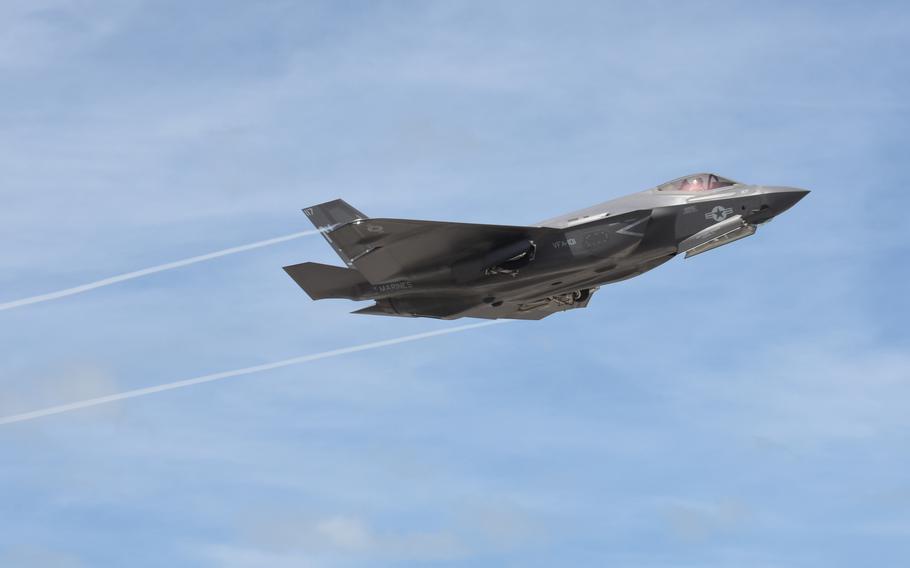
To meet the demands of great power competition and ensure strategic flexibility in the years ahead, the Navy must establish a permanent F-35 presence on the East Coast. (Cody R. Babin/U.S. Navy)
I came to Congress in 2023 with one goal in mind: to strengthen our national defense and support those who wear the uniform. As a former Navy helicopter pilot who deployed alongside carrier air wings, I understand what it takes to keep our country safe — and that begins with ensuring our forces are strategically postured for the threats of tomorrow.
The Navy’s ability to project air power in a contested environment depends on more than the capabilities of its aircraft — it depends on where those aircraft are based. Right now, every operational Navy F-35C squadron is stationed on the West Coast. That needs to change.
To meet the demands of great power competition and ensure strategic flexibility in the years ahead, the Navy must establish a permanent F-35 presence on the East Coast. Naval Air Station Oceana in Virginia Beach, Va., already the East Coast’s master jet base for F/A-18s, is the clear and logical choice to host the next generation of naval airpower. It’s time to expand Oceana’s mission and bring the F-35 to the East Coast.
While the F/A-18 Super Hornet has been the Navy’s tactical aviation workhorse for decades, the platform is aging and the Navy plans to begin retiring older models in the next decade. As the service transitions to fifth-generation capabilities and prepares for the eventual arrival of sixth-generation aircraft, the East Coast must be positioned to support that evolution. Oceana cannot remain the Navy’s tactical aviation hub if it’s left behind in the shift to next-gen airpower.
The F-35 is not just the future of naval aviation — it is a fifth-generation leap in lethality, survivability and interoperability. With stealth design, next-gen sensors and advanced data fusion, it is built for contested environments where legacy aircraft cannot operate. As China and Russia continue investing in anti-access technologies and precision long-range weapons, the Navy must be prepared to launch cutting-edge airpower from both coasts. A single Navy F-35 hub in California is, quite frankly, insufficient.
Establishing East Coast basing for the F-35 isn’t just a matter of convenience — it’s a matter of resilience and deterrence. A bicoastal force structure ensures that carrier air wings can be deployed globally, regardless of events at home like natural disasters, targeted strikes or cyberattacks. It also enables faster deployment to the Atlantic, the Mediterranean, the Arctic, and the Middle East — regions where naval aviation presence is essential.
NAS Oceana is ready. We’re not building from scratch — we’re building on decades of operational excellence. The infrastructure exists, the airspace is proven, and our surrounding Hampton Roads region is home to one of the most skilled defense workforces in the country.
With an array of installations and over 80,000 active-duty military personnel, Hampton Roads has one of the largest concentrations of armed forces in the country. Basing the F-35 here would support high-tech jobs, supply chain development and long-term defense investment. This is a win for national security and for local economic growth.
Congress has already shown bipartisan support for expanding the F-35 fleet. Now it’s time for our basing strategy to catch up with our investments. As a member of the House Armed Services Committee and a proud Navy veteran, I’ll keep fighting for a strategically balanced force posture that reflects today’s threats and tomorrow’s challenges.
The future of naval aviation must be flexible, distributed and combat-ready. That future begins at NAS Oceana.
Rep. Jen Kiggans, a Republican, represents Virginia’s 2nd Congressional District in the U.S. House of Representatives. She serves on the House Armed Services, Veterans’ Affairs, and Natural Resources committees. Prior to public office, she served 10 years as a U.S. Navy helicopter pilot, flying H-46 and H-3 helicopters and completing two deployments to the Persian Gulf, and then worked in the health care system as a Geriatric Nurse Practitioner.